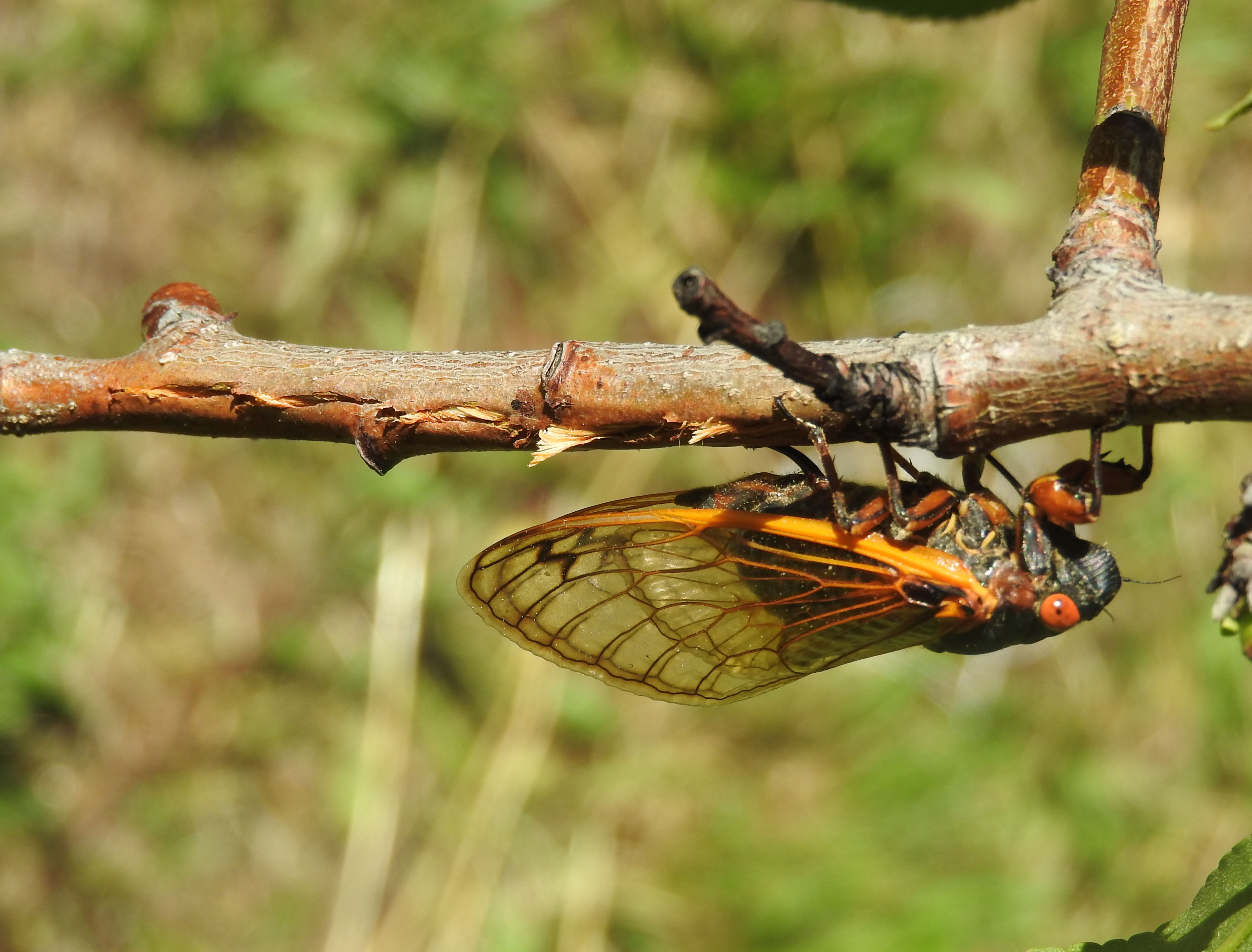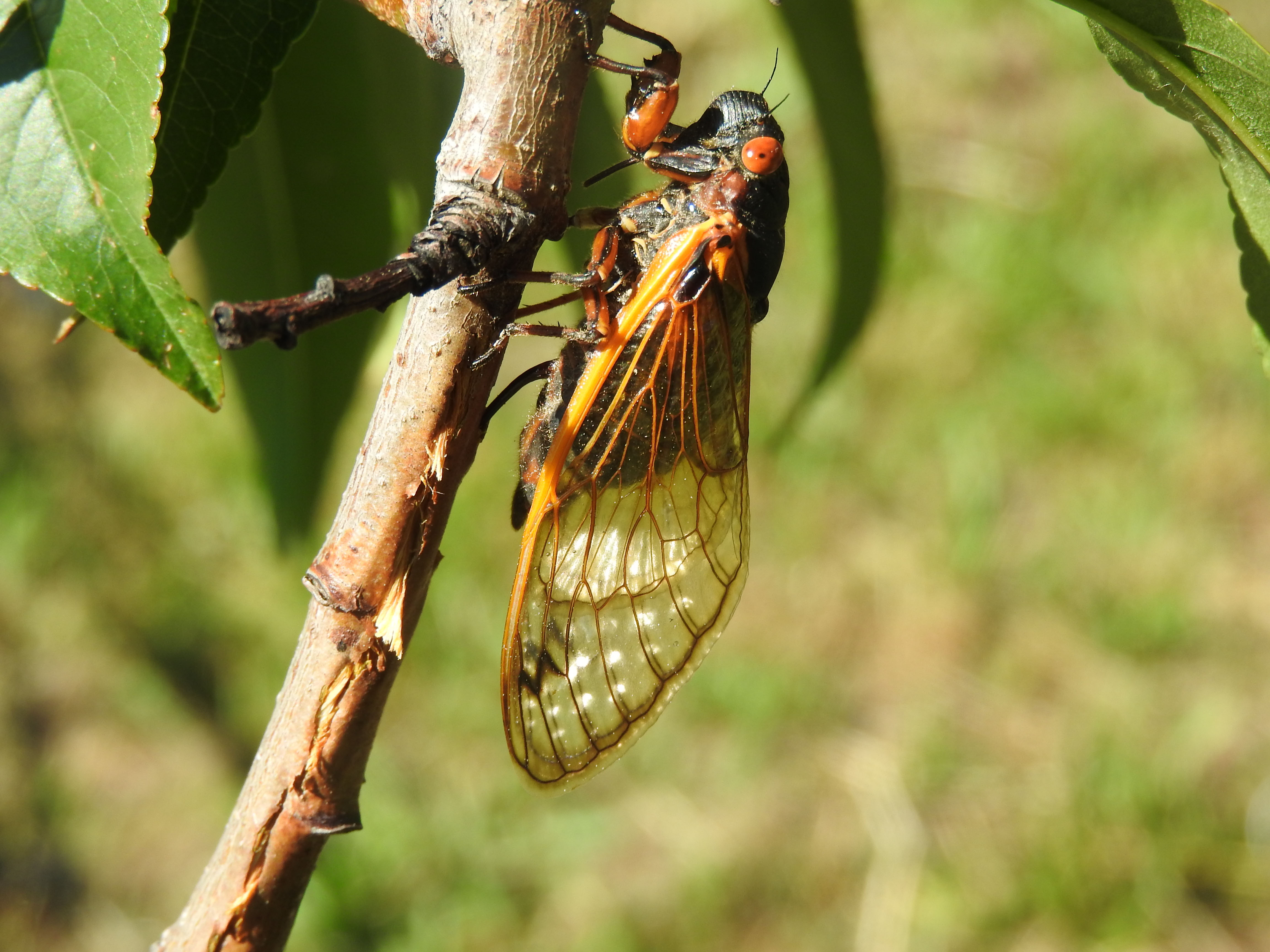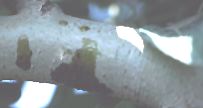
There are three species of seventeen-year cicadas [M. septendecim (L.), M. cassini (Fisher) and M. septendecula Alexander and Moore] and also three species of the more southerly ranging thirteen year cicadas (M. tredecim Walsh and Riley, M. tredecassini Alexander and Moore, and M. tredecula Alexander and Moore). Differentiating species of periodical cicada.
There were originally 30 broods of periodical
cicadas defined by Charles Marlatt, most separated
geographically (Broods I-XVII are 17-year species; XVIII-XXX are
13-year species). Not all are large enough to be horticulturally
important, and some have gone extinct. There are now about
15 active broods. Brood X is the most important numerically and
geographically; it last appeared in 2021; it will appear again
in 2038. Brood IX is the brood that will appear in 2037 in
southwest Virginia and adjacent North Carolina and Tennessee. Brood XIX (the great southern brood, a
13-year brood), will emerge in 2024. A map of the yearly
occurrence of the various broods in Virginia is given in a Virginia
Tech factsheet. Follow this link for a 20-minute
presentation on periodical cicada in Virginia and the Mid-Atlantic region.
Broods appearing in Virginia and nearby states (Click on Brood number for Marlatt's range map):
Brood I: The
Blue Ridge Brood: Western VA, WV (2012, 2029)
Brood II: East Coast Brood:
CT, MD, NC, NJ, NY, PA, DA, VA, DC. (2013, 2030)
Brood V: eastern OH, western MD,
southwestern PA, northwestern VA, WV, NY (Suffolk Co.)
(2016, 2033)
Brood IX: southwestern VA,
southern WV, western NC (2003, 2020, 2037)
Brood X: The Great Eastern
Brood: NY, NJ, PA, DE, MD, DC, VA, WV,
NC, GA, TN, KE, OH, IN, IL, MI (2004, 2021, 2038)
Brood XIV:
southern OH, KE, TN, MA, MD, NC, PA, northern GA, southwestern
VA and WV, parts of NY and NJ (2008, 2025)
Brood XIX (13 year): The
Great Southern Brood (2011, 2024, 2037)
An alternative way of looking at the broods is in order of next appearance. This may facilitate planning of planting dates for new orchard and vineyard blocks (see Cultural Control below):
Brood XIV: southern OH, KE, TN, MA,
MD, NC, PA, northern GA, southwestern VA and WV, parts of
NY and NJ (2025)
Brood I: The Blue Ridge Brood:
Western VA, WV (2029)
Brood II:
East Coast Brood: CT, MD, NC, NJ, NY, PA, DA, VA, DC.
(2030)
Brood V: eastern OH, western MD, southwestern PA, northwestern
VA, WV, NY (Suffolk Co.) (2033)
Brood IX: southwestern VA, southern WV, western NC
(2037)
Brood XIX (13 year): The Great Southern Brood (2037)
Brood X:
The Great Eastern Brood: NY, NJ, PA,
DE, MD, DC, VA, WV, NC, GA, TN, KE, OH, IN, IL, MI (2038)
Brood XIX (13 year): The Great Southern Brood (2037)
II. Hosts: The host range is very broad; almost any tree is attacked except for those that create sufficient gummy exudate to kill nymphs (e.g. pines). Apple is attacked very successfully. Stone fruits may be attacked, especially under heavy population pressure, but are less suitable hosts. Research in Pennsylvania has shown that if the wound is gummed, mortality of the egg mass can result. Gumming increases with the number of attacks per tree. Grapevines are readily attacked, but only young vines are considered to be at much risk.
III. Description: Adults have black bodies with red eyes and red-orange wing veins. Wings are clear and held tent-like over the body. Antennae appear as small bristles protruding from the head. Adult body length is 3/4 - 1-3/10 inch (19-33 mm), depending on species. Males can be identified by the upturned end of the abdomen and the presence of a tymbal just behind the wings. Females have a sharpened ovipositor, used for inserting eggs in wood, that is normally kept retracted in a groove along the underside of the abdomen (the ovipositor drops down for oviposition). Nymphs are seldom seen, since they cling to tree roots as they feed, holding the roots with their grasping front legs.
IV. Biology: Periodical cicada spends
most of its life as a nymph, feeding on xylem sap from tree
roots at a depth of 6-18 inches. In the final year of
development, nymphs crawl from the soil, climbing tree trunks or
any other structure. During the night, the nymphal skin splits along the midline,
and the adult emerges. Thousands of adults and exuviae (shed skins) may be found with each
tree in the orchard. Adults appear in mid May (a few individuals
may be heard as early as late April in Virginia - first
emergence wast noted on April 28, 2021 with Brood X). They
appear around sunset, males slightly preceding females. Males
form chorusing centers of great aggregations. The
characteristic sound made by males is produced by a membrane
called a tymbal, present only in males; this membrane on the side of the
first abdominal segment is backed by an air-filled resonating
chamber. (note the white
structure seen at the front end of the abdomen, just
behind the wings in this image). Sound is made by vibrating
the tymbal. The structure for hearing, the tympana, are present in both
sexes; these membranes are tucked beneath protective plates on
the underside of the insect. Singing
peaks around 10:00 AM. Adults feed on a wide range of woody
plants during the day; such feeding is apparently restricted to
the females since the male digestive tract is rudimentary.
Oviposition begins about 2 weeks after emergence. Females use
the ovipositor to make a series of slits in branches,
several slits occurring in a row. Eggs are inserted into twigs in groups of 10-25; the slit
into which the eggs are inserted is 1-4 inches (2.5-10 cm) long.
Females may lay over 500 eggs. Oviposition peaks in the early
afternoon. (See YouTube
oviposition clip).

Adults are active for about 6 weeks. Eggs hatch 6-10 weeks after oviposition, whereupon nymphs leave the twigs and drop to the soil. Nymphs tunnel to the roots where they establish themselves for feeding.
V. Injury: The main damage arises from oviposition wounds in twigs. The region distal to the wound dies. This can be very damaging to the structure of the tree, especially in young blocks. There is greater limb breakage during the season on cicada-injured trees. It is worthwhile to delay planting a block if an emergence is expected within one or two years. A second avenue of injury is feeding by the nymphs. A New York study showed that if nymphs were kept from reaching the roots, growth of apple trees was enhanced. Adults may also feed through bark, causing oozing of sap; this is probably of minor importance. In pear, shoot injury from periodical cicada can provide entry to the fire blight pathogen. Affected trees as well as neighboring trees may show flagging.
Injury in vineyards, young vines are subject to severe injury, with females using even the trunks as oviposition sites. (See photo by Lucie Morton). However even mature vines are subject to significant injury. If oviposition occurs beyond teh clusters, it may not be severe. But injury may occur on larger shoots as well, causing wilting and dieback. Oviposition may occur at multiple sites on one shoot or young trunk; affected areas become weak and will break easily (Eggs in the shoots may be seen on dissection of the injured material). Such young vineyards should be protected. Aluminum foil or some other physical covering of young trunks has been used successfully.

VI. Monitoring: During springs when
adult emergence is expected, watch for the appearance of adults
in the orchard. No thresholds are currently available. Treat
when aggregations begin to appear in the orchard.
VII. Control:
Cultural control: It is wise to avoid planting orchard or
vineyard blocks within 1-2 years before an expected emergence of
periodical cicada.
Mechanical control: Bird netting with a mesh no larger than 1 cm
will effectively control injury on branches (Hogmire et al. 1990).
Biological control: Ineffective because of predator
satiation strategy of periodical cicadas. The most important
natural enemies of periodical cicadas in the nymphal stage are
moles. Adults are fed upon by a range of birds, including
blackbirds, starlings, robins, blue jays, among others.
Various mammals will feed on adults - dogs and cats, opossums,
raccoons, etc. Bird may consume up to 40% of adults early in the emergence. But as cicada numbers increase, birds get satiated, and this effect may last for weeks (Williams et al. 1993). Eggs are attacked by parasitic wasps and
flies and predatory mites. Cicada killer wasps also attack later
adults, but these wasps are timed mainly for the later emerging
annual cicadas. A fungal disease, Massospora cicadina,
infects the adults. However, these natural mortality agents are
insufficient to provide control of the massive outbreaks typical
of periodical cicada. Periodical cicadas follow an
evolutionary strategy of predator satiation. A variety of birds, mammals and reptiles feed on adult cicadas because the insects do not invest in toxins for defense; however these predators do not significanly lower populations. There is an entomopathogenic fungus, Massospora, that may provide some natural mortality to periodical cicadas. There are compounds in Massospora that are psychoactive in cicadas, causing them to change their behavior (Boyce et al. 2019). Infected males will exhbit a behavior called wing-flicking, normally seen in sexually receptive females. When males approach the infected cicada, transmission of spores can occur (Cooley et al. 2018). One compound in Massospora, cathinone (Boyce et al. 2019), has been known to have psychoactive properties in humans (Langman and Jannetto 2020). But there is no record of eating Massospora-infected cicadas being harmful to birds or other predators.
Chemical control: Insecticides with rapid action are most
effective. Pyrethroids are the most effective class.
Assail is also effective (neonicotinoids are translocated in the
xylem, the same tissue where adult cicadas feed); percent
mortality is not as great as with the pyrethroids, but there is
less risk of induction of secondary pest outbreaks. Kaolin
clay, an organic option, will provide some reduction in injury.
Day, E., D. Pfeiffer, and T. Dellinger. 2021. Periodical cicada. VCE Fact Sheet, Pub. 444-276 (ENTO-403NP). Harris, R. 2020. Here comes the 17 year cicada chorus in SWVA. Online broadcast WVTF, NPR affiliate. 29 April 2020. https://www.wvtf.org/post/here-comes-17-year-cicada-chorus-swva. Accessed 29 April 2020.
Hogmire, H. W., T. A. Baugher, V. L. Crim and S. I. Walter. 1990. Effects and control of periodical cicada (Homoptera: Cicadidae) oviposition injury on nonbearing apple trees. J. Econ. Entomol 83: 2401-2404. Morona, J. 2019. Cicada recipes: How to cook these once every 17 years delicacies. Cleveland.com. https://www.cleveland.com/entertainment/2016/05/cicada_recipes_how_to_cook_the.html. Accessed 29 April 2020.
Pfeiffer, D. G. 2021. Periodical cicada appearance and management in the Mid-Atlantic region. (A 20-minute recorded presentation)